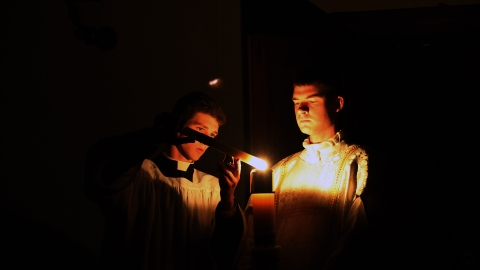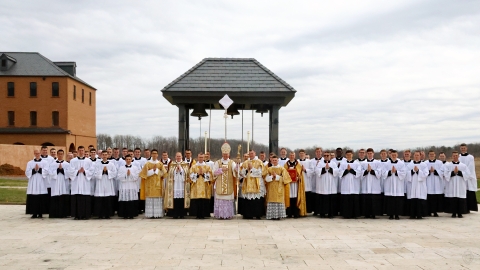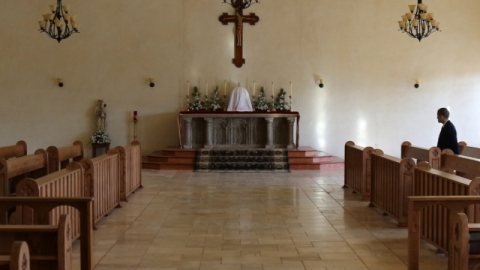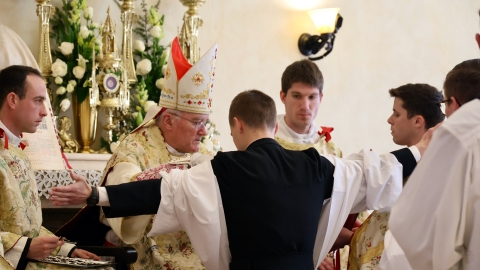Taking of the Cassock and Tonsure, Feb. 2, 2017

On February 2, Feast of the Purification of Our Lady, seventeen seminarians received the cassock and seven the clerical tonsure from the hands of His Excellency Bp. Bernard Tissier de Mallerais.
This event marked the first ordination ceremony to be held in the new Seminary. In contrast to Minnesota, the Virginia climate at this time of year is serene and welcoming; a sunny sky and a gentle breeze greeted the newly cassocked and tonsured when they stepped outside for a photograph after the ceremony.
As His Excellency blessed their cassocks, the seminarians, kneeling before him in gently sloping semicircle, spanned the length and width of the sanctuary. In his sermon Bp. Tissier dwelt for a while on the twofold importance of the cassock. For members of the SSPX, the cassock is one's religious habit, serving as an ever-present reminder of one's consecration to God. At the same time, it is a most effective means of apostolate, awakening in men their religious sense and drawing them back to an awareness of their duties towards God.
Addressing the future clerics, His Excellency explained that the tonsure is a sacramental--a sign instituted by the Church to give grace ex opere operantis Ecclesiae, i.e., by the "work" or intercessory power of the Church herself. The tonsure makes one a member of the Catholic clergy, with all the associated rights and duties. Pope Paul VI, Bp. Tissier noted, suppressed the clerical tonsure under the pretense that it was "outmoded" or no longer in keeping with the times. As a result, modern seminarians in the mainstream Church, until they receive the diaconate towards the end of their priestly training, are merely lay persons studying theology; they are students and nothing more. Our seminarians, on the other hand, have the consolation of knowing that they are not mere students of theology, but members of the Catholic clergy, with a real orientation toward the priesthood that is given them by the Church herself. Bp. Tissier attributed Archbishop Lefebvre's decision to keep the clerical tonsure to a special divine grace. It is not for ourselves alone that we are keeping the tonsure, he said, but for the whole Church.
The tonsure too, like the cassock, has its own symbolism; the cutting off of the locks of hair signifies the putting away of the old man with his worldly spirit. It means, in particular, saying a definitive farewell to certain activities and forms of entertainment that, even if not sinful in themselves, are unbecoming of a man of God and tend to debase the dignity of consecrated life. If this is a sacrifice, it is compensated by the joy of knowing that one belongs to God in a special way and that one is serving Him more perfectly than before. Anyone who leaves behind friends, family and property to serve Jesus Christ will receive a hundredfold in this world, together with persecutions, and life everlasting in the next (cf. Mk. 10:30).
Conferral of the Cassock and Tonsure
It is the practice of the Society to give the cassock and tonsure on the day when the Church commemorates the presentation of the Infant Jesus in the Temple. This is because both ceremonies, of cassock and tonsure, express the giving of one’s life to the service of God. On the day of his presentation in the Temple, the Christ child offered himself to the Father with a generosity that surpasses our understanding, embracing in advance the sufferings and sacrificial death that He knew this offering entailed. In this way our Lord provided an example of magnanimity to be imitated by all who aspire to participate in his priesthood. The very rites of the reception of the cassock and tonsure call for this magnanimity.
The Cassock—A Visible Change
Firstly, the change in clothing of those who take the cassock signifies the interior transformation of the heart—contempt for the world, death to self, and a new life in Jesus Christ. In the blessing of the clerical habit, the Church prays that “these thy servants, having put on this garment, may likewise put on Thee.” The language is taken from St. Paul: “Put ye on the Lord Jesus Christ, and make not provision for the flesh in its concupiscences” (Rom. 13:14).
Black for Death
The black color of the cassock signifies death to the world and to self. The world, in this sense, is nothing other than the rebellion of creatures against God, which always springs from disordered self-love and is fomented by the attractiveness of created goods when they are sought after without any reference to the divine Goodness. Concerning this, St. John says, “Love not the world, nor the things that are in the world…for all that is in the world, is the concupiscence of the flesh, and the concupiscence of the eyes, and the pride of life” (1 Jn. 2:15-16).
This mystical death is an aspect of the Christian life stressed by St. Paul. “Know you not that all we, who are baptized in Christ Jesus, are baptized in his death? For we are buried together with him by baptism into death…Our old man is crucified with him, that the body of sin may be destroyed, to the end that we may serve sin no longer…So do you also reckon, that you are dead to sin, but alive unto God, in Christ Jesus our Lord” (Rom. 6:3-11). The cassock reminds the one who wears it, as well as all around him, of the necessity of this self-renunciation, after the example of Christ. “Christ died for all, that they also who live, may not now live to themselves, but unto him who died for them, and rose again” (2 Cor. 5:15).
The Tonsure
The clerical tonsure signifies the same thing. Five locks of hair are cut from the seminarian’s head in the form of a cross. It is a giving of self and the renouncing of everything superfluous and vain. The Church prays on behalf of the tonsured that the Holy Ghost may “defend their hearts from the entanglements of the world and worldly ambition.” As their hair is being cut, the ordinands say, “The Lord is the portion of my inheritance and my lot; it is Thou who wilt restore to me my inheritance” (Ps. 15:5).
By the tonsure, the young men become clerics, members of the clergy. The word “cleric” comes from the Greek kleros, which means “portion” or “lot.” Those who dedicate themselves to the service of God have God himself as their promised reward, even as He was the special inheritance of the priestly tribe of Levi, who did not receive a portion of the Promised Land. “You shall possess nothing in their land,” the Lord said to Aaron, “neither shall you have any portion among them; I am thy portion and inheritance in the midst of the children of Israel” (Num. 18:20).
The Surplice
After the tonsure the new clerics receive the surplice. White in color, it signifies “the new man, who is created according to God in justice and holiness of truth.” The surplice is put on over the cassock as the positive aspect of the Christian life, which follows upon the negative aspect, death to self. “If any man will come after me, let him deny himself, and take up his cross, and follow me” (Mt. 16:24). What happens if we follow Christ? “He that followeth me, walketh not in darkness, but shall have the light of life” (Jn. 8:12). Christ is the light of the world; as Simeon said, “A light to the revelation of the Gentiles, and the glory of thy people Israel” (Lk. 2:32).
The prophet Malachias had foretold that the Lord would come to his Temple “as a refining fire” and would “purify the sons of Levi” so that they would “offer sacrifices to the Lord in justice” (Mal. 3:1-3). Christ is a fire that purifies the heart, enlightening it with faith and inflaming it with the warmth of charity. The Church prays for the tonsured, that Christ may send the Holy Ghost to “open their eyes from all spiritual and human blindness and bestow on them the light of eternal grace.”
Petition
We may conclude, then, with the petition that Holy Mother Church makes at Candlemas: “Lord Jesus Christ, the true Light who enlighten every man coming into this world…mercifully grant that, even as these lights, enkindled with visible fire, dispel the darkness of the night; so may our hearts, enlightened by an invisible fire—the splendor of the Holy Ghost—be free from all blindness of vice, so that, with our mind’s eye cleansed, we may be able to perceive what pleases thee and conduces to our salvation; so that, after the murky perils of this world, we may deserve to attain to the unfailing light.”





